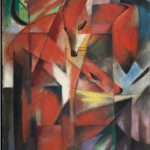
Brussels.- “The Power of Fantasy: Modern and Contemporary Art from Poland”, as major exhibition gathering many of the most significant works of contemporary art from Poland by a generation of artists who have made their careers since the fall of communism in the country in 1989, is on view at the BOZAR Arts Center in Brussels from June 24th until 18 September. More than 30 internationally renowned artists such as Monika Sosnowska, Wilhelm Sasnal, Piotr Uklañski, Katarzyna Kozyra, and Robert Kuœmirowski are featured in the show. Divided throughout the 19th century, occupied during the Second World War, and subsequently under the Soviet yoke for decades, Poland became a democracy in 1989.
 In this wounded country, victim of a succession of oppressive regimes, there developed a flourishing culture that gave expression, down the centuries, to a spirit of resistance to any order imposed from outside. Via the absurd and the fantastic, Polish artists reacted to the chaos of the real world with art imbued with a spirit of resistance, not in order to flee reality, but with a view to reconstructing it. The exhibition will show the work of internationally renowned contemporary artists, including Miroslaw Balka, Monika Sosnowska, and Wilhem Sasnal. Their works will be juxtaposed with seminal Polish works of art from the 19th and 20th centuries. Seeing these works side by side brings home just how deeply rooted the exploration of the fantastic and the irrational is in Polish art.
In this wounded country, victim of a succession of oppressive regimes, there developed a flourishing culture that gave expression, down the centuries, to a spirit of resistance to any order imposed from outside. Via the absurd and the fantastic, Polish artists reacted to the chaos of the real world with art imbued with a spirit of resistance, not in order to flee reality, but with a view to reconstructing it. The exhibition will show the work of internationally renowned contemporary artists, including Miroslaw Balka, Monika Sosnowska, and Wilhem Sasnal. Their works will be juxtaposed with seminal Polish works of art from the 19th and 20th centuries. Seeing these works side by side brings home just how deeply rooted the exploration of the fantastic and the irrational is in Polish art.
Entitled “The Power of Fantasy” the exhibition sets out to show how the fantastic and the magical, the mad and the absurd have been powerful themes in contemporary Polish art. With works of art which explore the full potential of the imagination, the show reveals a culture full of intense visions and strange dreams. These themes also provide connections between 20th century modern art in Poland and the practice of contemporary artists since 1989. The exhibition puts contemporary artworks in the company of iconic masterpieces by celebrated artists like Tadeusz Kantor, Magdalena Abakanowicz and Bruno Schulz. In total, The Power of Fantasy features almost 200 works of art, some especially commissioned for this exhibition including a work of wall art being made in situ by street artist, Mariusz Waras. Other major works are being shown outside Poland for the first time. The Power of Fantasy is the most comprehensive exhibition of contemporary Polish art since the end of communism. The artworks are not ordered by chronology, but are organized thematically in different chapters. Key themes include absurdity in everyday life; history and memory; the image of the hero; madness and absurdity; surreal landscapes; the militant imagination; the art of saying no.
Fantasy takes a variety of forms. In the work of neo-surrealist painter Julian Jakub Ziólkowski as well as the Baroque filmic fantasies of Katarzyna Kozyra, it is conveyed in feverish excess. For other artists, it is the former socialist environment – much disparaged in the popular imagination – which has power to stimulate the imagination. As art, ordinary towns and streets can become a magic world containing many overlooked possibilities and unfulfilled potential. Concrete housing blocks and public buildings become playgrounds of the imagination in the work of Monika Sosnowska, Julita Wójcik and Jaroslaw Kozakiewicz. For this generation of artists, like others before them, fantasy has not been a way of escaping reality but of challenging it. Largely born in the late 1960s and 1970s, they have crossed two worlds: their childhoods and youth were lived in the People’s Republic of Poland, whilst their careers have been made in democratic Poland. Their work is inflected by a contrarianism that cast doubt on both. In this way – artists like Artur Zmijewski and Zbigniew Libera – sustain a tradition of dissent and critical reflection which is deeply-rooted in Polish culture. Polish artists are deeply interested in the ways in which history can be folded into the present. Robert Kusmirowski’s iconic work, ‘DOM’, a C19th graveyard will be recreated in the show. The exhibition also features a room of works of Wilhelm Sasnal – one of the greatest painters of the age – addressing the figure of the hero.
The fantastic can also be shaped out the ordinary. Hardship, bureaucracy and censorship have not been entirely negative experiences for Poland, at least in the sense that they have stimulated a remarkable resourcefulness in the nation. Poles have a talent of being able to make anything out of nothing. In the 1950s Leopold Tyrmand writing called this capacity ‘Applied Fantasy’. Today artists continue to tap this resourcefulness: Pawe? Althamer works with the elderly neighbours and teenage ‘homeboys’ from Bródno, an unloved suburb in Warsaw, to create art or as he calls it a ‘wspólna sprawa’ (‘common task’). A monumental sculptural collective self-portrait, ‘Bródno People’, made by Althamer and his neighbours will feature in the exhibition. Other young artists demonstrate extraordinary, even perverse resourcefulness. Jan Simon, for instance, combines approaches technology like a craftsman, making electronic objects from scratch. Maciek Kurak has commented on the talent for ‘Applied Fantasy’ in a piece called ‘Fifty-Fifty’ in which a Polish FIAT car – on its back – seems to drive a sewing machine.

Playing a key role in the cultural life of Brussels for over 70 years, the Palais des Beaux-Arts (or BOZAR) is a not just a home for art exhibitions, but also a mecca for the city’s music and dance and also the home to the Belgian National Orchestra. The Palais des Beaux-Arts owes its existence to Henri Le Boeuf, a music-loving financier. He commissioned the architect Victor Horta to design a centre that would bring together multiple artistic disciplines under the one roof. Horta’s brief was to design a centre that would house concert halls and exhibition space that would cater for music, theatre, cinema and art. The design had to make art accessible to as many people as possible and in as many different forms as possible, but without compromising on standards. Several challenges were faced by Horta in his design, not least of which was the sloping land he had to work with. The location’s close proximity to the Palais Royale also meant that his building was not to allowed to obstruct the palace’s line of view down to the city. Horta had therefore to look underground to find his space. It took seven years (from 1922 to 1929) for the art deco complex to be completed, requiring him to alter his plans six times. There are three concert halls: The Henry Le Boeuf Hall seats 2,200 concertgoers and its oval shape is a delight to both the ear and the eye. The 476-seat Chamber Music Room is located under the Great Sculpture Hall. And, there’s the Studio which seats 210. In 1962 the Musee du Cinema was established in the Palais. Apart from its fine archive and exhibition of old cameras and lenses, it also screens classic films. There’s a range of music, expo, theatre and dance events taking place at the Palais des Beaux-Arts daily. Visit the BOZAR Center’s website at … http://www.bozar.be







